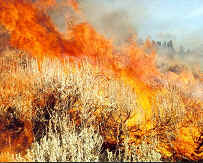Advanced
GIS Applications in Fire Ecology and Management
Fall
semester 2005 - NR506
Eva Strand
| October
12 - November 18,
2005, Tuesdays and Thursdays 12:30 - 2:20 pm, room 26 CNR |
Course goals and objectives:
2. GIS overlay analysis - occurrence of fire in relation to topography and vegetation
3. Compile fire atlas information in ArcInfo to better understand historic and present fire patterns, disturbance regimes and landscape change. Computation of fire frequency and fire rotation.
4. Remote Sensing application - estimating fire severity using the Delta NBR Index and understand the relationship to BARC maps.
5. GIS raster models - binary models and index models
6. Using VDDT (Vegetation Dynamics Development Tool) box-models to simulate landscape level succession and disturbance.
7. Develop input GIS data layers to be used in landscape modeling tools such as Landsum, TELSA and Farsite. Typical input data: Elevation, slope, aspect, landcover, fuel models, structure etc.
8. GIS integration of spatially explicit landscape models such as Landsum and TELSA with GIS.
9. Understanding the Fire Regime Condition Class concept
10. Overview of GIS and Remote Sensing applications in the the National Fire Plan
Click for Syllabus
Reading 1: Gollberg G.E., Neuenschwander L.F., Ryan K.C., 2001. Introduction: Integrating spatial technologies and ecological principles for a new age in fire management, International Journal of Wildland Fire, 10, 263-265.
Reading 2: Rollins M.G., Swetnam T.W., Morgan P., 2001. Evaluating a century of fire patterns in two Rocky Mountain wilderness areas using digital fire atlases, Can. J. For. Res. 31:2107-2123.
Reading 3: Chang K., 2002. Geographic Information Systems, Chapter 14 - GIS Models and Modeling, McGraw-Hill Companies, Inc.
Reading 4: Keane R.E., Burgan R., van Wagtendonk J., 2001. Mapping wildland fuels for fire management across multiple scales: Integrating remote sensing, GIS and biophysical modeling, International Journal of Wildland Fire, 10, 301-319
Reading 5: Hann W.J. and Bunnell D.L., 2001. Fire and land management planning and implementation across multiple scales, International Journal of Wildland Fire, 10, 389-403
Reading 6: Morgan P., Hardy C.C., Swetnam T.W., Rollins M.G., Long D.G., 2001. Mapping fire regimes across time and space: Understanding coarse and fine-scale fire patterns, International Journal of Wildland Fire, 10, 329-342
Reading 7: Rollins et al., 2004. Mapping Fuels
and Fire Regimes using Remote Sensing, Ecosystem Simulation, and Gradient
Modeling, Ecological Applications 14(1): 75-95.
Web site readings
Delta
NBR Lab - http://edc2.usgs.gov/fsp/severity/fire_main.asp
Fire Regime Condition Class concept - http://www.fire.org/frcc/
Landfire, National Fire Plan - http://www.landfire.gov
Forest Service Region 1 Fire Info - http://www.fs.fed.us/r1/fire2001/
PowerPoints
Geo-database
Labs
Lab 1 - Introduction and Incident Mapping
Lab 2 - Overlay Analysis (10%)
Lab 3 - Progression maps (10%) *Useful ArcWorkstation commands*
Lab 4 - Regions; computation of fire frequency and fire rotation (10%)
Lab 5 - Introduction to the Geodatabase
Lab 6 - GIS Raster Models (10%) *NBR cheat -sheet*
Lab 8 - Vegetation Dynamics Development Tool (VDDT) (10%)
Lab 9 - Landfire and FRCC lectures (Penny Morgan)
Lab 10 - Fire Regime Condition Class Lab (10%)
Rapid
Assessment Models
GFDF
- Grand fir / Douglas-fir
PPDF
- Ponderosa pine / Douglas-fir
MGRA
- Grassland
Lab 11 - Presentation by Casey Teske
Work on final project in class
Lab 12 - Work on final project in class
Final Project - evaluation of presentation (40%)
